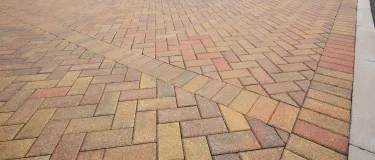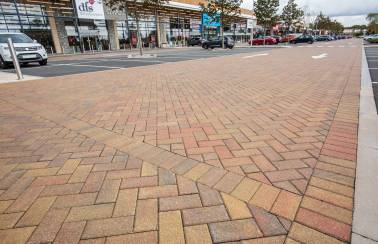The time is now to integrate SuDS into every future urban design project
Ian Geeson, Technical Manager at Charcon, the commercial hard landscaping division at Aggregate Industries, considers how integrating Sustainable Urban Drainage Systems (SuDS) into every future urban design project could play an essential part in effective water management. Advice is also provided on designing and planning SuDS for effective delivery and visual appeal.
In the natural environment, a high proportion of rainfall soaks into the ground and filters its way into rivers and is carried away. However, in the urban environment, due to the extensive use of hard surfaces, water is unable to soak away and results in high volumes of surface water run-off. This water enters drainage systems that were never designed to have the capacity to cope with such high volumes of water.
There are a number of high performance and cost effective SuDS solutions readily available to manage the issue of surface water runoff. However, too often during the design process, the role SuDS can play in urban design and effective water management is misunderstood, an afterthought – or perhaps forgotten entirely.
Urban Design & Effective Water Management
There is a common misconception that SuDS can only be used in certain applications. But in fact, they can be applied to any residential, commercial or urban project, in towns or built-up city centres. And whilst they can’t prevent flooding, by introducing permeable surfaces coupled with water storage and infiltration systems, surface water run-off will decrease, relieving pressure on drainage and sewer networks. This will ultimately help reduce potential flooding. The use of these techniques is well proven and documented.
While SuDS technology is not a new concept in the UK, architects, designers and engineers often forget that there is much more to SuDS than water storage. Certainly, it should help reduce water run-off and the risk of flooding but it can also help remove pollutants and create societal and biodiversity benefits. This means that water run-off that is treated within the SuD system can then be harvested for irrigation, biodiversity or amenity use within a development – or can simply be recycled. If you look at SuDS this way, as an architect, the design opportunities are countless.
The Government’s change in approach to implementing SuDS through the planning system is a very clear call for architects, designers and engineers to lead the way, developing multi-functional SuDS as part of the design process. With a holistic, design-led approach, the issue of drainage should just become an integral part of the process – and not an end in itself. Indeed, by integrating SuDS with urban design, the architects, designers and engineers will be able to better deliver amenity and community value as well as improving the character of the landscape and townscape.
However, to achieve this, surface water management needs to be linked to development planning from the very start of a project. This will allow space to be used more effectively and in a multi-functional way, enabling water storage and conveyance zones to form part of the development’s character.
It will also maximise the drainage system’s capacity for delivering multiple planning and environmental benefits. Wherever possible, the 2013 Code of Practice BS 85823 suggests incorporating permeable surfaces and surface-based conveyance. This could be porous concrete and asphalt – or when aesthetics is high on the agenda, concrete block permeable paving.
Whereas traditional drainage systems are constrained by capacity, SuDS solutions have no such constraints. SuDS solutions incorporating permeable paving allow water to soak naturally where it falls into the pavement below. Such systems can be designed to address a number of key issues such as water quantity, water quality, trafficking and biodiversity. By considering these key issues in the design you can develop drainage systems that reduce the impact of high levels of rainfall on communities and wildlife.
Designing and planning for SuDS
The Code of Practice3 advises that permeable surfaces and surface-based conveyance and storage systems should be used in conceptual designs wherever practical. It also highlights the importance of linking multi-functional SuDS design to other development infrastructure, such as car parking and public open space. Indeed, a recent SuDS paper presented at the Building Centre looked at clever design responses to flood risks and considered the innovative designs that leading architects are proposing, which seek to live with water, rather than just defend against it.
The permeable pavement can be designed to treat the water as it passes through the system, removing water-borne pollution, meaning it can be used in landscape design, harvesting and ecology. This also supports the ethos of ‘living with water, rather than defending against it’.
The reality of flooding on homeowners and the importance of designing for flooding cannot be overstated. As water filtrates through the system, many of the pollutants are treated or removed within the pavement before the water is stored or gradually released into the drainage network or natural infiltration. Concrete block paving can be used in almost all circumstances, full infiltration to the ground, partial infiltration with excess water directed to the next SuDS stage; or full containment and controlled release to the next SuDS stage.
Concrete block permeable paving is ideally placed to meet the Code of Practice3 requirements and is a good choice for architects looking for a truly holistic, design-led solution. There’s an extensive range of permeable paving options available now and the styles, finishes and colours available means architects can have real design freedom when deciding on the aesthetics for the streetscape. In addition, the performance of these products is comparable, arguably better, than standard pre-cast concrete paving products. Permeable paving not only provides a level, firm and slip-resistant surface, it removes the needs for cross-falls, channels and gulleys.
Furthermore, correctly designed, concrete block permeable paving can support heavy trafficking and loads, making it ideal for all shared surfaces and residential roads, as well as car parks and hard landscaping. A real benefit to the client, of course, is that very little maintenance of a permeable paving system is required – and as there’s no need to install below-ground drainage, ongoing cost and maintenance is kept to a minimum, if SuDS is designed in from the start of the project.
The industry needs to grab the opportunities that SuDS presents with both hands. Earlier engagement with landscape architects and/ or SuDS manufacturers will help ensure the right SuD solution is identified for the project – whether that’s permeable hard landscaping systems of soft SuDS, such as ponds, filter drains, artificial concrete streams etc. In doing so, architects, designers and engineers will be able to achieve effective delivery, visual appeal and a sustainable solution for the future.
Aggregate Industries offers a range of SuDS options including concrete block permeable paving, interlocking cavity grid systems, porous asphalt, porous concrete and open graded granular sub-base. Its technical support team can offer comprehensive advice on SuDS and assistance with system development, product selection and installation processes.
www.charcon.com
Press contacts
-
Telephone
01530 510066
-
Email







